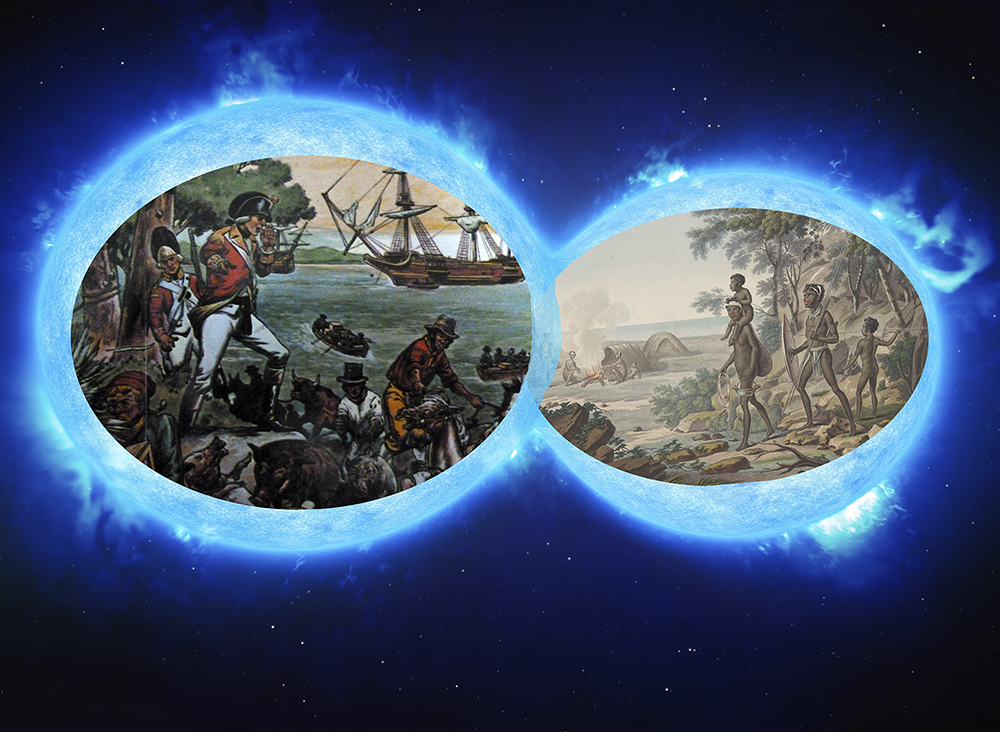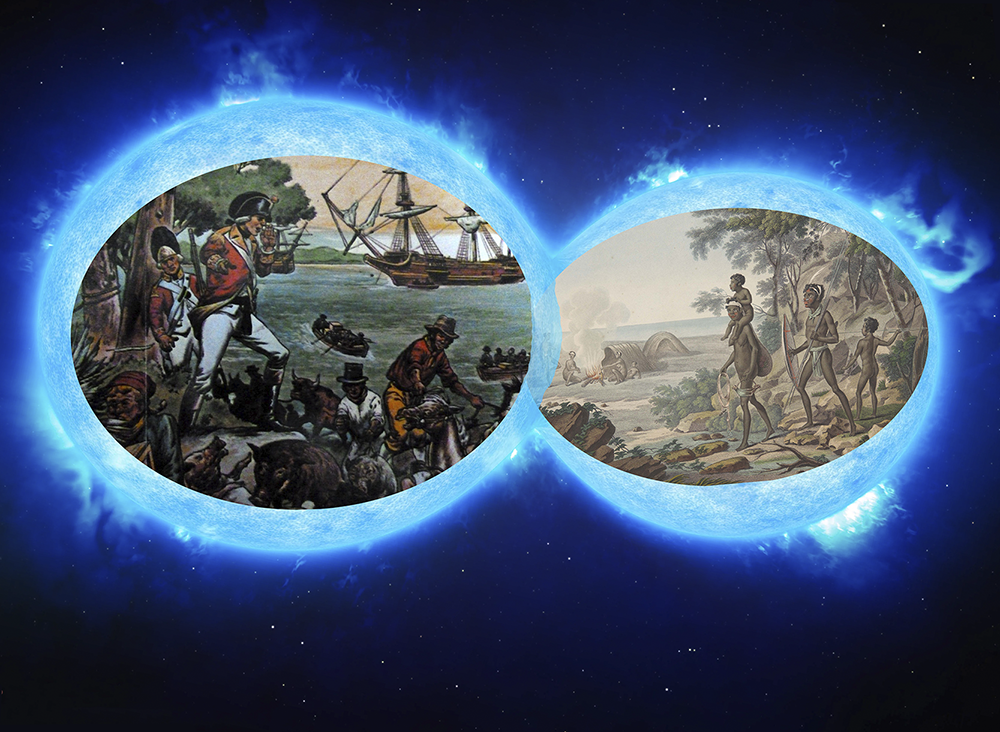British settlement’s biggest threat to blackfella mobs was a loss of hunter gatherer lifestyle

The 1788 British settlement’s biggest threat to local native, mobs was the loss of their hunter gatherer way of life. Today we have a stealthful transfer of all Australian citizen’s common-wealth to a select faction of Aboriginal owned corporations.
In the first year of British settlement the local natives attacked unarmed convicts and fishermen, and sporadically, armed officers and soldiers. No one grasped that living a tribal life as a local native was all these people had known in their existence. What was being threatened was their hunter gatherer domestic arrangement. The only lifestyle they had ever known.
By the end of the first year of settlement, four marines, 27 male convicts, 13 female convicts and 11 children had died of illness, four had been killed by local natives, five were executed and 14 were lost in the bush or at sea, presumed dead.
On 1st September 1790, five convicts were set to sea and presumed drowned. Their boat wreck was unearthed close to Port Stephens a few years later. Four of the convicts were subsequently captured when they were found alive and well living peacefully nearby with a mob of local natives.
Banished from their motherland the convicts sent to Sydney Cove fashioned a spirited settlement with farms and families and new foundations. Instead of being chained and tormented many of these outcasts moulded vivacious and productive neighbourhoods. They relished the relative freedoms they were given by being released from a walled British gaol life into the progressive penal outpost far across the deep blue sapphire ocean seas from their homeland.
Smallpox is one of the most contagious and deadly diseases to have plagued humanity. Right through its stretched history, hundreds of millions of people all over Earth have been infected and about three out of ten of those humans died from the disease. All infected have symptoms which progress quickly and include fever, headache and backache as well as a severe pustular rash. Death could come within a day or two of infection. Those who survived were often badly scarred, many had very pox scarred faces, were blinded or both.
15 months after the First Fleet arrived a major smallpox epidemic broke out in the new colony. The outbreak did not affect many of the British settlors as most had been exposed to the disease during their infancy and immune. The long sea voyage of the First Fleet meant that the travellers would have died of the disease or recovered. So the First Fleet did not transport smallpox from Britain.
No one knows how the smallpox virus arrived and the precise number of local natives that died in the epidemic is difficult to determine. Governor Arthur Phillip estimated that around half of the local native people living around Sydney Cove died during the three month outbreak. Many are thought to have died of hunger and thirst while too sick to seek food and water, and that children had often perished beside a dead parent. Left to die in their helpless situation for want of sustenance.
Low population density would have made it difficult for the smallpox virus to travel far from Sydney Cove.
Under the fatherly eyes of Governor Arthur Phillips the penal outpost started to take on the look of a small English town. Many of the convicts while still under sentence lived in their own freestanding cottages with private gardens residing among family or friends. In their free time they could nurture and farm their garden. Upon expiry of their sentence 30 acres of land was offered to convicts to take or leave as they so desired.
The marines who volunteered to go to New South Wales were free to be discharged after three years’ service. This group of men never became oppressive or tyrannical and earned the trust and respect of convicts, local natives, and received praise from the Governor, Captain Arthur Phillip.
Within two or three years of arrival these marines were constructing and occupying their own dwellings outside the military quarters. They built comfortable cottages with gardens they could farm themselves. 30 or so had brought their wives and children on the voyage whilst others opted to take convict women as wives or mistresses during their time in Sydney. Their frequent expeditions into the hinterland opened up much of the Sydney plain for further settlement. Many volunteered their trade skills to help protect and build the new settlement from the ground up and became the first schoolteachers, armourers, police, ship-builders, and masons.
The Marines remained as the first garrison of Sydney Town between 1788 and 1792. They were relieved by a specially formed army unit – the New South Wales Corps. Once discharged the original marines became free settlers and some transferred to the new army detachment while others sailed home to Britain.
The first self-starting free settlers from Britain arrived at Port Jackson in January 1793 on the Bellona. These people, five men, two women with six children, had made their own decision to migrate to the new colony and were prosperous enough to have paid their own way. These immigrants were given land grants at Liberty Plains.
For the new immigrants this was to be a self-sufficient farming settlement utilising the labour of convicts.
So with the assistance of families and convict labour, the new immigrants cleared the land they had been given and cultivated wheat and corn. But, the fertility of the ground was depleted within five years, resulting in their families being left dependent on government rations.
In the early 1800’s the British government started to pay the transportation costs for many migrants who received free land on the proviso that the land be used for a productive purpose. The government gave the free settlers free agricultural tools and convict labour to help them establish their farms. Children in more wealthy families had more privileged lives than other child immigrants who were expected to work hard alongside their mothers and fathers.
Local natives who wanted to make the land productive were given land grants.
Life was not easy for nearly all of Australia’s early settlers. The colony almost collapsed in its first few years. Crop failures compelled the settlers to rely on infrequent supplies transported in by ship. Food was so scarce that everyone from the convicts to Governor Arthur Phillip received measured rations.
Ultimately the settlers learned to farm their own food under Australian conditions.
The population expanded with new arrivals of more convicts and free settler pioneers. Increased trade and industry converted the fledgling penal settlement into a buzzing port within a generation.
The infant mortality rate amongst local natives is known to be high. Natural weather events such as flooding rains, severe droughts and raging bushfires for a very long time have had a devastating effect on all livings species across the Australian continent at various times.
250 years after the fact, estimates of the number of local native occupants across the mainland Australian continent when Lieutenant James Cook, captain of the HMB Endeavour, landed varies from 300,000 to more than a million people. The simple truth is no one really knows. No one will ever really know. And an inclusive society would not care.
The modern divisive blackfella land grab rights movement started in Australia in the 1960’s. The protective lines for Australian citizens are slowly and surely being diminished into private freehold ownership of more and more land by a small minority of the population. A stealthful transfer of all Australian citizen’s common-wealth to a select faction of First Nations Aboriginal owned corporations.
Aboriginal land rights and native title rights are ‘payback’ for the perceived ‘sins’ of benevolent dead whitefellas. Modern exclusion legislation enforced upon the Australian citizens by the Australian and state and territory governments who really cannot be blind to the racist intent of the activists with the microphone.
The pusillanimous politicians are not blind to the truth of their action when they sheepishly say they are ‘doing the right thing’ and fail to explain to the citizens what they are pilfering from this generation and all the generations to come.
For what? Who gains peace, prosperity and happiness from this government cave in to First Nations Aboriginal activists with the loudest microphone?
It is time for honest dialogue to stop the rot in greedy, just plain wrong First Nations Aboriginal Land right activism.
